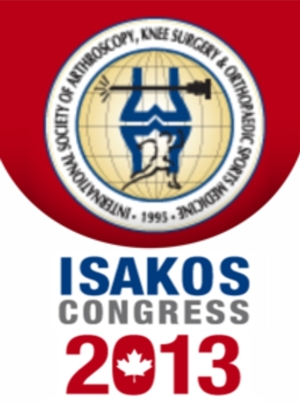
ISAKOS: Free or Restricted Rehabilitation After Meniscus Repair

ISAKOS: Free or Restricted Rehabilitation After Meniscus Repair
The Impact of Free or Restricted Rehabilitation After Meniscus Repair. A Prospective Randomized Clinical Trial
Did you know you're eligible to earn 0.5 CME credits for reading this report? Click Here
CONFERENCE ACE REPORTS
This ACE Report is a summary of a conference presentation or abstract. The information provided has limited the ability to provide an accurate assessment of the risk of bias or the overall quality. Please interpret the results with caution as trials may be in progress and select results may have been presented.
Synopsis
60 patients who had undergone arthroscopic repair of vertical meniscus lesions were randomized to either a free or a strict rehabilitation program after to compare the functional, healing, and patient related outcomes of the two protocols. Follow-up at one year follow demonstrated a slightly better healing rate for the free rehabilitation group, with no differences between the groups in Knee Osteoarthritis Outcome Score (KOOS), Tegner score, pain and patient satisfaction.
Why was this study needed now?
Meniscal tear occurs in the cartilage during a number of physical activities. Currently no randomized controlled trials exist to investigate the best rehabilitation program for meniscal repair. The purpose of this trial was to compare the outcomes of free and restricted rehabilitation program on meniscal healing.
What was the principal research question?
How does free rehabilitation compare to strict rehabilitation in terms healing rates, functional, and patient-related outcomes, 1 year after meniscal repair surgery?
What were the important findings?
- 33% of restricted and 24% of free rehabilitation patients had partial or lack of healing with re-arthroscopy.
- Both groups had similar KOOS scores
- No differences in Tegner score were found between two groups
- Patients reported similar satisfaction with either rehabilitation
What should I remember most?
Free rehabilitation demonstrated a slightly better healing rate for meniscal repair, but no differences were found in functional outcomes and patient satisfaction at a one year follow up.
How will this affect the care of my patients?
Free rehabilitation seams to show a trend towards better healing rates, despite similar functional outcomes between two rehabilitation protocols. Future follow up of 2 years for this study is currently being awaited, while the lack of healing remains a concern.
Learn about our AI Driven
High Impact Search Feature
Our AI driven High Impact metric calculates the impact an article will have by considering both the publishing journal and the content of the article itself. Built using the latest advances in natural language processing, OE High Impact predicts an article’s future number of citations better than impact factor alone.
Continue



 LOGIN
LOGIN

Join the Conversation
Please Login or Join to leave comments.